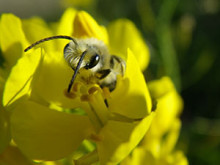— from Russel Barsh —
 When local food producers raised concerns a year ago about the possible impact of neonicotinoids on local bees, the islands’ nonprofit scientific cooperative Kwiaht was curious about whether this new generation of persistent pesticides was already being used widely in the San Juan Islands.
When local food producers raised concerns a year ago about the possible impact of neonicotinoids on local bees, the islands’ nonprofit scientific cooperative Kwiaht was curious about whether this new generation of persistent pesticides was already being used widely in the San Juan Islands.
“Pyrethroids are in most of the pesticide products sold here, while neonicotinoids are found in very few home-and-garden products,” says Kwiaht director Russel Barsh. “Most neonicotinoids are in large-scale agricultural use in the Midwest and Southeastern states for example on citrus groves.” But even a small amount of local use could affect the islands’ bees if it forms residues on the pollen grains that bees eat and feed to their young.
Previous Kwiaht studies have found pyrethroid pesticides in clams dug from the beaches at Eastsound. Barsh wondered whether pyrethroids or neonicotinoids could be found in pollen from the pears, plums, roses and other ornamentals around Eastsound.
“The good news is that we did not detect neonicotinoids on local pollens at part-per-trillion levels,” Barsh says. “The bad news is that local pollens are contaminated with pyrethroid pesticides at a level of one to two parts per billion. That’s not enough to kill bees outright, but it may affect their behavior.”
Both neonicotinoid and pyrethroid pesticides are modified versions of naturally occurring chemical compounds that some species of plants make to protect themselves from chewing and sucking insects such as aphids. They are neurotoxins that shut down the nervous systems of insects within seconds of exposure. As little as one microgram of these pesticides (one millionth of a gram) can kill a wasp or carpenter ant. They also kill non-target insects such as butterflies and bees, as well as marine arthropods such as crabs and shrimp. Sprays produce aerosols (tiny droplets floating in air) that can drift for miles, and many neonicotinoid and pyrethroid pesticides can persist in water or soil for months to years.
Orcas Middle School student Emma Thoron, Salmonberry School student Sofia Fleming and Erica Berdan helped with the pollen study, which used immunoassays and a BioTek 808 absorbance microplate reader recently acquired by Kwiaht for teaching and research with the support of private donors on the island. The Orcas Island Community Foundation also contributed generously for purchasing supplies.
Kwiaht is preparing an illustrated guide to dozens of species of native bees found on Orcas, many of which are mistaken for wasps or simply overlooked. Also supported by the Orcas Island Community Foundation, the bee guide will be freely available to the community in print and on-line.
**If you are reading theOrcasonian for free, thank your fellow islanders. If you would like to support theOrcasonian CLICK HERE to set your modestly-priced, voluntary subscription. Otherwise, no worries; we’re happy to share with you.**









It seems that people forget that what is put into our environment has an effect on our Whole Ecosystem. The kindest action we can take for All Life is to start a compost pile or buy Organic compost and to garden Organically. We can’t begrudge little critters a tasty meal. If you find they eat too much of one plant there may be an imbalance in the soil. It too, needs to be fed! PH testing of the soil helps. There are ecologically friendly ways to balance the soil! It is All on the Internet!
We have to stop feeding corporate profits and start feeding the soil! Talk to your plants! They too, respond to LOVE!
Spirit Eagle
Worm bins are an inexpensive way to compost. Anything goes into them, and the compost is loved by the garden.. Buy a large metal garbage can, drill holes around the bottom, sink it into the ground up to 2-3 inches from the top. Start it with wet straw or grasses, add worms, bungee cord the top…. you are on the way to less garbage!